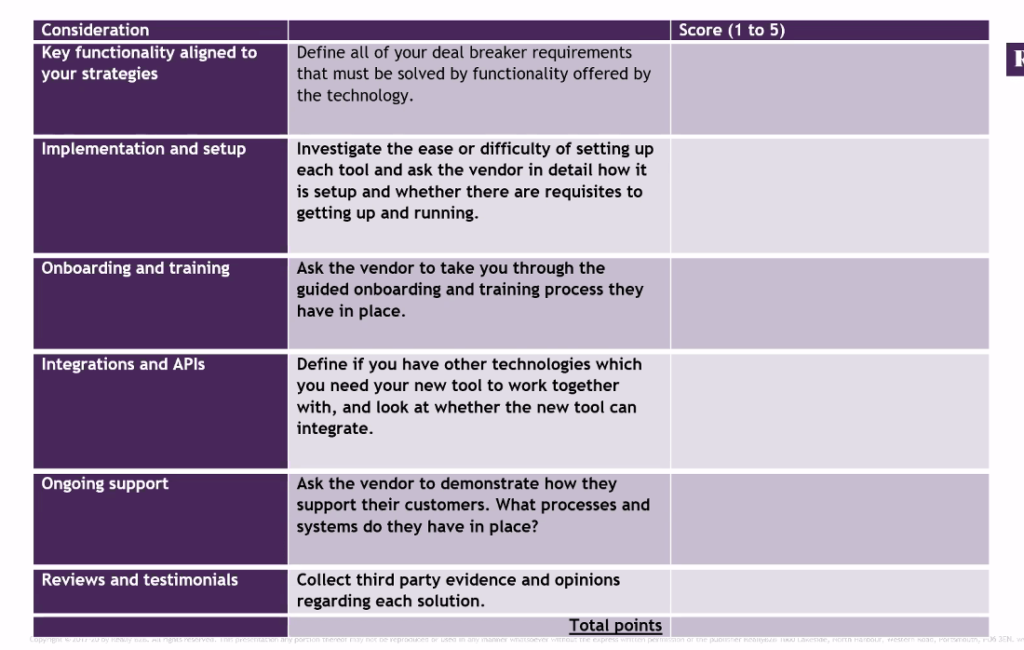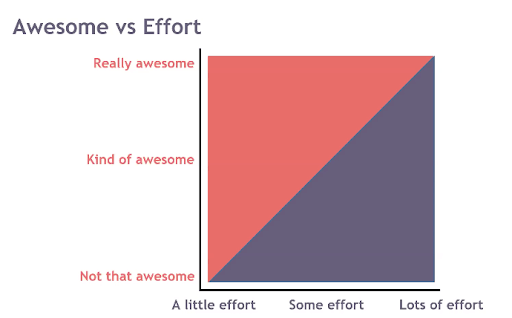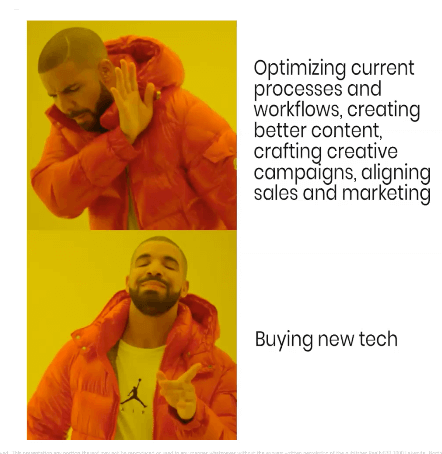As Head of Marketing Automation for Really B2B, an inbound marketing strategy agency, Ash Chandler has seen many marketing tools live and die. With over 15 years of experience in all things martech, he has been a buyer, vendor, user and tester of all many different tools and wanted to share a bit of his wisdom.
In his Marketing Wild Wild West conference on Saloon, Ash wanted to address the special relationship marketers have with their tools. Rather than criticizing tools bluntly, he wants all of us to think hard when considering a new tool. Are all our tools really useful? Did we pick them for the right reasons? How to know if they are made for us and our team? Here is our summary of his talk:
1. Two things not to trust: habit and martech vendors
The two uglies of a marketers life are at either end of the spectrum. On the one hand, habit and preconceptions can push us towards the wrong tool; on the other, trusting martech vendors and their promises can blind us and make us run into the arms of a time-consuming tech behemoth. But if you can’t trust your habits or vendors, how can you pick the perfect tool?
1.1 Lose all of your misconceptions
“It’s always been done this way” and “everybody uses this (bs) technology so we have to” are, according to Ash, the ugliest sentences a marketer can use.
Relying on habit too much can hinder your job in the long run. It’s by continually questioning your processes, messages and media that you can, step by step, enrich and refine your strategies for better performance.
Constantly watching your competitors in order to copy what they are doing because you are afraid to be left out will, on the other hand, leave you in a race you can never win. Ash’s advice? Turn the question around.
Rather than wondering, “Will this tool give us a better process to follow ?”, let’s ask ourselves: “Can this tool help us improve our existing the existing process, according to our criteria (and no one else’s) ?” Truth is, depending on our goals, our answers (and pick of tools) will be very different: do we want to buy time? Improve our ROI? Give our coworkers space to be creative? Send more mail? Produce more content? There are many tools for this -and one might be exactly what you need. It just might not be the same as your competitor.
Ash also recommends not to fall for the “big tech” sirens. If a marketing automation solution feels like it can do absolutely everything for you, it might be a trick. Let’s say your team isn’t too tech-savvy or has very specific needs: do you think this “mega tool” will fit your every need? Your team, in that case, might not be open to change and tech differences. If it looks too good to be true, it probably is! Always prefer a more agile, smaller tool that answers and adapts to your problems and your timing.
In order not to lose sight of what matters, Ash recommends to:
- review everything, from the performance of your tools to your team’s processes ;
- be specific in what you want;
- be bold, and don’t be afraid to switch if a tool is not working for you.
1.2 Don’t trust martech vendors (too much)
Ash knows all about the big bad martech vendors. They hold all the aces, have great tools, and they know we need and want them. Vendors play on our thirst for technology, making it look shiny and attractive… at the risk of blinding us. Thankfully, Ash shared his two-step method to make sure you don’t get swindled:
- Ask your peers for help and advice. Why did they choose a certain tool? Are their processes the same as yours, their objectives too? With their help, you will be able to centre the discussion with vendors about what their tech can bring to strengthen your strategy, not the other way around. Do not underestimate the influence their functionalities can have on your workflows.
- Make a shortlist of questions and grill your vendors with it. Make sure to come into the discussion as objective as possible and take the time to map out your processes and your demands. Treat this purchase as an IT one and not a marketing one. Ash’s consideration table (below) regroups categories of questions you might want to ask.
Ash also gives us two bonus questions to consider when buying a marketing automation tool:
- Can the vendors share a roadmap of their tool, a year or two in the future? Can they tell you what they intend to do with it, what elements will be added or improved?
- Does this tool have a great online community of users? This could be an advantage to get the most of the tool online and never be stuck.
2. 4 things to consider when buying a marketing automation tool
Ash took the opportunity to share with us the 4 things he considers when buying marketing automation software.
1.The “Awesome VS effort” factor
Ash quotes Tom Scott, UK YouTuber, with his “awesome vs effort” scale. If the definition of “awesome” is not scientifically attainable, this matrix helps us put our values and processes at the heart of the decision-making process. In short, we ask ourselves two questions:
- Does what we are doing require lots of effort?
- Are the results good (awesome) or not?
Some amazing results deserve lots of efforts, of course. They should not be discarded, but improved: can we find a method, process or tool to reduce the effort notion?
At the opposite, when thinking about gearing up with a new tool, let’s ask ourselves if the expected results are worth the effort required to implement it.
2.Don’t expect the wrong thing from the right tool, and vice versa
Every tool has its functionalities and strengths. In marketing automation especially, Ash says we tend to expect the wrong thing of our tools -another reason to make a list ahead of what we need and expect of it.
Drawing the boundaries for every tool we use is a great way to use them to their full potential: if we know it, we’ll use it even better.
3.Do not give up on the marketing funnel just yet
Many people claim that the marketing funnel is dead. For Ash, it still has a good place to help -if you do not see it as a static thing.
The marketing funnel helps draw a line in the sand and should be treated as a method: add some steps that make sense to your company, fast passes that depict your prospect’s journey more accurately. As a rule, let’s not discard good models just because we read somewhere it was not in fashion anymore. If it fits you, it will work.
4. Remember to document everything
We know, we know -you just sighed reading those words, didn’t you? No one likes documentation, and marketers even less. We do not have enough hours in a day to do what we must, so taking hours to document everything seems like the last thing we would do. Sadly, it’s an essential part of your strategy and, even more so, if you handle several tools at once.
Good documentation will help you:
- spare some time in onboarding new users;
- lay down some values and ground rules for the use of your tools;
- create conventions (such as naming) and keeping everything neat and tidy for whoever helps you or replaces you in the future.
3. The ugliest in all marketing? Martech itself
Martech is its own worst enemy, says Ash. There are over 8000 marketing tools available nowadays, for around 150 in 2010. If all have their knacks and specifics, they keep on piling onto the ever-present noise in marketing. This noise stops marketers from focusing on their strategies and, sadly, keeps us focused on strategies we can horseshoe into a new set of functionalities we want to try -for no other reason than the fact that others talked about it. Others feel like they are not up to scratch when they don’t have the latest technology fad in their toolbox.
This back and forth motion is the most dangerous thing for us marketers. If we lose sight that it’s our product, our brand and our messages that deserves most of our time, there is no amount of technology that will save us. Technology is supposed to fit on top of all these elements -it’s the means, not the end.
Our choice of tools, in the end, doesn’t matter this much. Our marketing automation tool must first and foremost come to strengthen our existing process and systems to make them more efficient. It cannot become the reason you prefer a strategy for another. In short, let’s always ask ourselves: “what will we be able to do better thanks to this tool”? To replay Ash’s conference, his advice and case studies, head over to Saloon!








